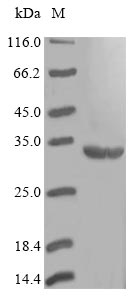Recombinant Staphylococcus haemolyticus Dihydropteroate synthase (folP) gets expressed in E. coli, spanning the complete 1-267 amino acid sequence. The protein carries an N-terminal 6xHis-tag, which makes purification and detection straightforward. SDS-PAGE analysis confirms the product reaches greater than 90% purity—a quality level that appears suitable for most research applications.
Dihydropteroate synthase plays a crucial role in folate biosynthesis. The enzyme drives the condensation reaction between para-aminobenzoate and pteridine, ultimately forming dihydropteroate—a critical step toward folic acid production. What makes this enzyme particularly interesting is its vulnerability to sulfonamide antibiotics, which may explain why it has become such an important target in antibiotic resistance research.
Potential Applications
Note: The applications listed below are based on what we know about this protein's biological functions, published research, and experience from experts in the field. However, we haven't fully tested all of these applications ourselves yet. We'd recommend running some preliminary tests first to make sure they work for your specific research goals.
Staphylococcus haemolyticus dihydropteroate synthase (FolP) is a bacterial enzyme that catalyzes a key step in folate biosynthesis. The E. coli expression system is homologous to this bacterial protein, significantly increasing the probability of correct folding. The N-terminal 6xHis tag is small (∼2 kDa) and unlikely to sterically interfere with the enzyme's active site or dimerization. FolP requires proper folding for its enzymatic activity in converting p-aminobenzoic acid (pABA) and dihydropteridine pyrophosphate to dihydropteroate. Therefore, this recombinant FolP has a high probability of being correctly folded and functionally active.
1. Protein-Protein Interaction Studies Using His-Tag Pull-Down Assays
This recombinant FolP may be suitable for studying interactions with potential partners in the folate biosynthesis pathway. The homologous expression system and minimal His-tag ensure native conformation. Pull-down assays can reliably identify physiological interactors such as other folate pathway enzymes or regulatory proteins. The >90% purity minimizes non-specific binding. Any interaction data would be biologically irrelevant without validation using a natively folded protein. The protein folding needs to be validated before experiments.
2. Antibody Development and Validation
This recombinant FolP serves as an excellent immunogen for generating specific antibodies against S. haemolyticus dihydropteroate synthase. The full-length sequence ensures comprehensive coverage of the epitope. The high purity (>90%) minimizes antibodies against contaminants. These antibodies will be valuable for detecting FolP in bacterial samples and studies of expression regulation.
3. Biochemical Characterization and Enzyme Kinetics Analysis
This is a priority application for validating functional activity. Techniques like enzyme kinetics assays can determine kinetic parameters (Km, Vmax) with substrates pABA and DHPP. Thermal shift assays and circular dichroism can be used to analyze stability and secondary structure. The high purity enables accurate quantitative measurements.
4. Comparative Folate Pathway Studies
This protein has potential for comparative studies with FolP enzymes from other bacterial species. Functional comparisons of substrate specificity, inhibitor sensitivity, and kinetic parameters can reveal evolutionary adaptations. The standardized expression ensures valid cross-species comparisons.
Final Recommendation & Action Plan
This recombinant FolP expressed in its homologous E. coli system with a minimal His-tag is highly likely to be properly folded and functionally active, making it suitable for all proposed applications. The recommended approach is to begin with Application 3 (Biochemical Characterization) to confirm enzymatic activity with standard FolP substrates. Once activity is validated, proceed confidently with Applications 1, 2, and 4 for interaction studies, antibody development, and comparative analyses. For drug discovery applications, this protein is particularly valuable for screening sulfonamide antibiotics and studying resistance mechanisms.






